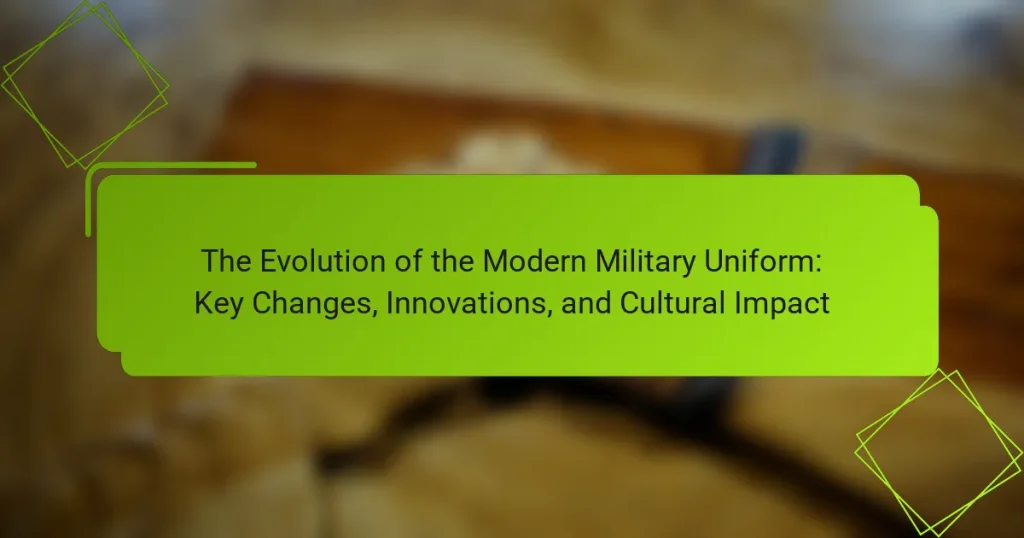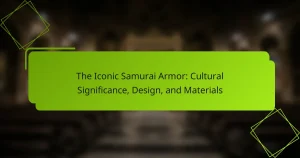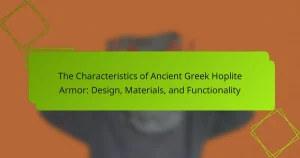The modern military uniform has undergone significant evolution, reflecting advancements in technology, changes in warfare, and shifting societal norms. Initially designed for visibility, military uniforms transitioned from bright colors to camouflage in the early 20th century to enhance concealment on the battlefield. Innovations such as synthetic materials, modular designs, and advanced camouflage patterns have improved durability, comfort, and adaptability for soldiers. Additionally, modern uniforms address cultural sensitivity and gender inclusivity, highlighting their role in representing military values and national identity. This article examines the key changes, innovations, and cultural impacts of military uniforms throughout history.
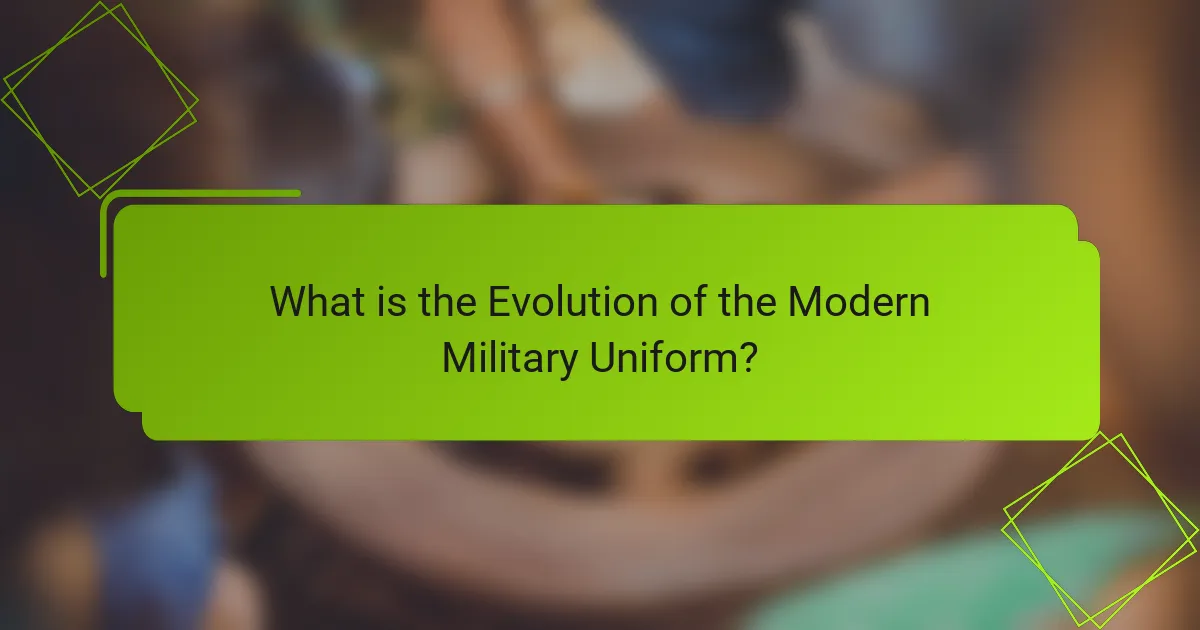
What is the Evolution of the Modern Military Uniform?
The evolution of the modern military uniform reflects changes in technology, warfare, and societal norms. Initially, military uniforms were designed for visibility and identification. Bright colors and distinct patterns were common in the 18th and 19th centuries. The introduction of camouflage in the early 20th century marked a significant shift. Camouflage aimed to conceal soldiers in various environments. World War I saw the widespread adoption of such designs.
Post-World War II, uniforms incorporated synthetic materials for durability and comfort. The Vietnam War popularized the use of jungle fatigues. The late 20th century introduced modular designs for adaptability. Modern uniforms often include advanced materials for moisture-wicking and temperature regulation. Today, military uniforms also consider cultural sensitivity and gender inclusivity.
These changes reflect the military’s response to evolving combat conditions and societal expectations. The continuous development of military uniforms demonstrates their importance in both functionality and identity.
How have military uniforms changed over time?
Military uniforms have evolved significantly over time. Initially, uniforms were designed for visibility and identification, often in bright colors. In the 19th century, practicality became more important, leading to the adoption of muted colors and durable fabrics. The introduction of camouflage during World War I marked a major shift, prioritizing concealment in combat. Post-World War II, uniforms began to incorporate modern materials, enhancing comfort and functionality. The late 20th century saw an emphasis on utility, with modular designs and specialized gear for various environments. Today, military uniforms reflect both technological advancements and cultural considerations, balancing tradition with modern needs.
What historical events influenced these changes?
The evolution of the modern military uniform was influenced by several historical events. The Napoleonic Wars introduced the concept of standardized uniforms for military units. The Industrial Revolution brought advancements in fabric production and dyeing techniques. World War I necessitated functional designs for trench warfare, leading to the adoption of khaki and camouflage patterns. World War II further emphasized practicality and protection, resulting in the development of more durable materials. The Cold War era saw the introduction of specialized uniforms for different climates and environments. Each of these events contributed to the ongoing transformation of military attire, reflecting both technological advancements and tactical needs.
What are the key milestones in military uniform evolution?
The key milestones in military uniform evolution include the introduction of standardized uniforms in the 17th century. This marked a shift from individual clothing to uniforms that represented military units. In the 19th century, the use of khaki began during the Second Anglo-Afghan War, providing camouflage in combat. The World Wars saw the adoption of more functional designs, integrating pockets and durable materials. Post-World War II, the introduction of synthetic fibers revolutionized uniform production. The Gulf War highlighted the importance of desert camouflage patterns. Recent advancements focus on technology integration, such as moisture-wicking fabrics and body armor. Each milestone reflects changes in warfare, technology, and military identity.
Why is the design of military uniforms significant?
The design of military uniforms is significant because it serves multiple essential functions. Uniforms enhance identification and cohesion among service members. They establish a visual representation of military branches and ranks. Additionally, the design influences the effectiveness of soldiers in various environments. For example, camouflage patterns improve concealment in combat situations. Historical evidence shows that uniform design has evolved to meet changing warfare needs. In World War I, for instance, the introduction of khaki uniforms marked a shift towards practicality. The design also reflects cultural values and national identity. Overall, military uniforms play a crucial role in operational effectiveness, morale, and representation.
How do uniforms reflect military identity and values?
Uniforms reflect military identity and values by symbolizing discipline, unity, and service. They visually distinguish service members and promote a sense of belonging. Military uniforms often incorporate insignia that represent rank, branch, and accomplishments. This fosters pride and accountability among personnel. Specific colors and designs can convey heritage and tradition, reinforcing the values of honor and sacrifice. For example, the U.S. Army’s camouflage patterns aim to enhance operational effectiveness while maintaining a connection to the military’s historical roots. Overall, uniforms serve as a tangible representation of the ideals and commitments of the armed forces.
What role do uniforms play in morale and discipline?
Uniforms play a significant role in enhancing morale and discipline within military settings. They foster a sense of unity and belonging among personnel. When individuals wear the same uniform, it creates a collective identity. This shared identity can boost morale by promoting camaraderie and teamwork.
Additionally, uniforms establish a standard of professionalism and order. They serve as a visual representation of authority and discipline. The presence of a uniform can deter misconduct and encourage adherence to regulations. Historical evidence shows that well-dressed military units often perform better in high-pressure situations.
Research indicates that uniforms can positively influence behavior and attitudes. A study published in the Journal of Social Psychology found that uniforms enhance group cohesion and individual commitment to group goals. Thus, uniforms are crucial in maintaining morale and discipline in military organizations.

What are the Key Innovations in Military Uniform Design?
Key innovations in military uniform design include advanced materials, modularity, and camouflage technology. Advanced materials enhance durability and comfort. For example, moisture-wicking fabrics improve soldier performance in various climates. Modularity allows for customizable gear, enabling soldiers to adapt their uniforms for specific missions. This flexibility has become essential in modern warfare. Camouflage technology has evolved significantly, incorporating patterns that blend with diverse environments. Digital camouflage patterns, like the U.S. Army’s Universal Camouflage Pattern, improve concealment. Additionally, integrated technology, such as wearable sensors, is being explored to monitor soldier health and performance. These innovations collectively enhance operational effectiveness and soldier safety.
How has technology impacted military uniform development?
Technology has significantly impacted military uniform development by introducing advanced materials and design techniques. Modern uniforms now utilize lightweight, durable fabrics that enhance mobility and comfort. Innovations such as moisture-wicking and temperature-regulating materials improve soldier performance in various climates. Additionally, camouflage technology has evolved, allowing for patterns that adapt to different environments. Integrated technology, like built-in sensors and communication devices, enhances situational awareness. Historical examples include the adoption of flame-resistant materials following increased exposure to IEDs in combat. These advancements reflect the military’s commitment to improving the safety and effectiveness of personnel.
What materials are commonly used in modern military uniforms?
Modern military uniforms are commonly made from synthetic fabrics, cotton blends, and specialized materials. Synthetic fabrics, such as nylon and polyester, provide durability and moisture-wicking properties. Cotton blends offer comfort and breathability for soldiers. Specialized materials like ripstop fabric enhance resistance to tearing and abrasion. Additionally, uniforms may incorporate flame-resistant materials for safety in combat situations. These choices reflect the need for functionality and protection in various environments. The evolution of these materials has been influenced by advancements in textile technology and the demands of modern warfare.
How do innovations enhance soldier performance and safety?
Innovations enhance soldier performance and safety through advanced materials and technology. Modern uniforms incorporate lightweight, breathable fabrics that improve mobility. These materials also offer better moisture-wicking and temperature regulation. Enhanced camouflage patterns reduce visibility to enemies, increasing stealth. Integrated technology, such as communication devices, allows for real-time information sharing. Body armor innovations provide superior protection against ballistic threats. Additionally, smart textiles can monitor health indicators, ensuring soldiers’ well-being. Research shows that these advancements lead to increased operational effectiveness and reduced injury rates in combat situations.
What are some notable examples of innovative military uniforms?
Notable examples of innovative military uniforms include the U.S. Army’s Operational Camouflage Pattern (OCP) and the British Army’s Multi-Terrain Pattern (MTP). The OCP was introduced in 2015, designed for versatility in various environments. It enhances concealment in both woodland and desert settings. The MTP, adopted in 2010, features a blend of colors for effective camouflage in diverse terrains.
Another example is the Israeli Defense Forces’ (IDF) uniform, which incorporates moisture-wicking and quick-drying fabrics. This innovation improves soldier comfort and performance in harsh conditions. The U.S. Marine Corps introduced the Marine Corps Combat Utility Uniform (MCCUU) in 2002, featuring a digital camouflage pattern for improved effectiveness in combat.
The French Army’s Félin system integrates advanced technology into uniforms. It includes communication systems and enhanced protection. These innovations reflect ongoing advancements in military uniform design, focusing on functionality and adaptability.
How did camouflage patterns evolve in military uniforms?
Camouflage patterns in military uniforms evolved to enhance concealment in various environments. The earliest forms of camouflage were solid colors used in World War I. Soldiers quickly recognized the need for patterns that blended with natural surroundings. By World War II, disruptive patterns became popular, featuring irregular shapes and colors. This shift aimed to break up the outline of soldiers against different terrains. Post-war innovations led to the development of digital camouflage patterns. These patterns utilized pixelated designs to provide effective concealment at varying distances. Research has shown that effective camouflage can significantly reduce detection rates in combat scenarios. As warfare evolved, so did the technology and design of camouflage patterns, adapting to new combat environments.
What is the significance of modular uniform systems?
Modular uniform systems are significant because they enhance adaptability and functionality in military operations. These systems allow for customization based on mission requirements. Soldiers can mix and match components for optimal performance. This flexibility improves comfort and operational effectiveness. Modular systems also facilitate quick repairs and replacements. They can adapt to various environments and climates efficiently. Historical data shows that modular designs have increased soldier satisfaction and mission success rates. Thus, the significance of modular uniform systems lies in their ability to meet diverse operational needs effectively.
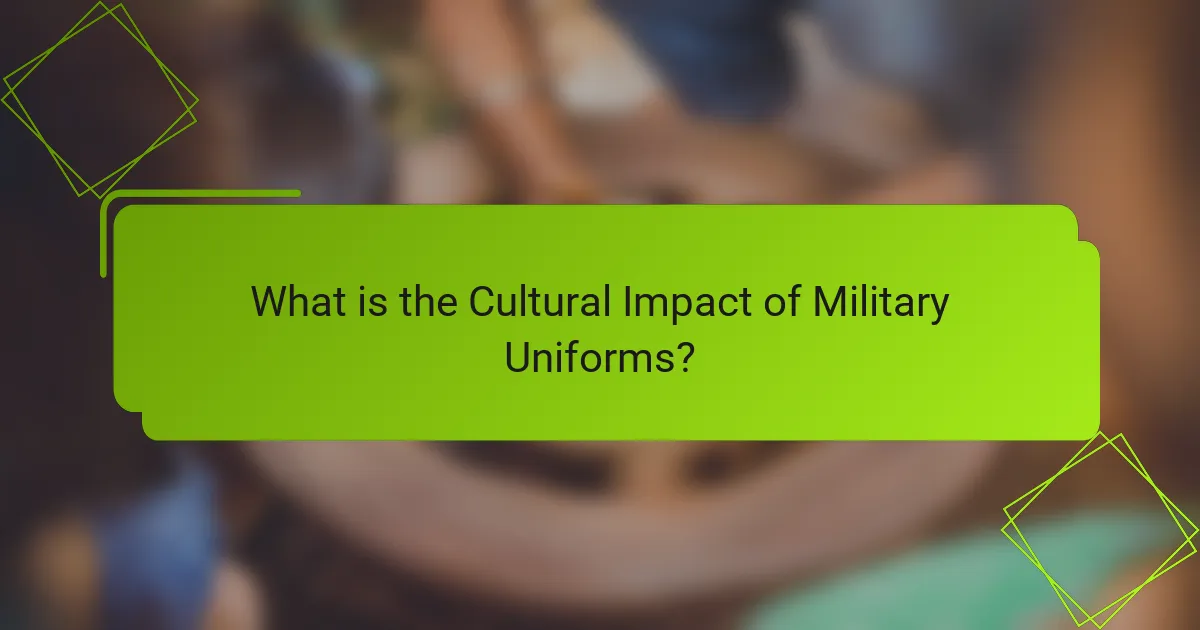
What is the Cultural Impact of Military Uniforms?
Military uniforms significantly influence culture by symbolizing authority and national identity. They serve as visual representations of military values such as discipline and sacrifice. The design of military uniforms often reflects historical and cultural contexts. For example, the adoption of camouflage patterns in the 20th century transformed perceptions of warfare and military engagement. Uniforms can also inspire fashion trends, as seen in civilian clothing that incorporates military styles. Additionally, military uniforms play a role in ceremonies and parades, fostering a sense of pride and unity among service members and the public. Historical events, such as World War II, further cemented the cultural significance of military attire in various societies.
How do military uniforms influence public perception?
Military uniforms significantly influence public perception by symbolizing authority, discipline, and national pride. They create a visual representation of military identity and values. The design and color of uniforms can evoke feelings of respect and admiration. For instance, the iconic camouflage pattern is associated with stealth and protection. Studies show that individuals in uniform are often perceived as more trustworthy and competent. Historical events, such as parades and ceremonies, reinforce the positive image of military personnel. Uniforms also foster a sense of unity and belonging among service members. Overall, military uniforms shape societal attitudes towards the armed forces and their role in national security.
What role do uniforms play in national pride and identity?
Uniforms serve as symbols of national pride and identity. They visually represent a nation’s values, history, and culture. Military uniforms, in particular, evoke feelings of honor and sacrifice. They often incorporate national colors and insignia, reinforcing a sense of belonging. For example, the U.S. military uniform features stars and stripes, embodying American ideals. Research shows that uniforms can enhance group cohesion and loyalty among service members. This connection fosters a collective identity tied to national service. Historical events, such as parades and ceremonies, further solidify uniforms’ role in national identity. Overall, uniforms act as powerful tools for expressing and reinforcing national pride.
How are military uniforms represented in popular culture?
Military uniforms are often depicted in popular culture as symbols of discipline and heroism. They appear in films, television shows, and video games, reinforcing the image of soldiers as protectors. Iconic representations include movies like “Saving Private Ryan” and series such as “Band of Brothers.” These portrayals emphasize bravery and sacrifice. Additionally, military uniforms are used in fashion, influencing trends and styles. Designers frequently incorporate elements of military attire into civilian clothing. This cultural representation shapes public perception of the military. It can evoke feelings of respect or critique based on the context of the portrayal. Overall, military uniforms serve as powerful cultural symbols in various media.
What are the implications of military uniform changes on society?
Military uniform changes can significantly impact society by influencing perceptions of authority and identity. New designs often reflect cultural shifts and societal values. For example, the adoption of camouflage patterns in the 20th century marked a shift towards modern warfare and a focus on stealth. This change also affected public perceptions of military effectiveness and professionalism. Additionally, uniforms can symbolize national pride and unity, impacting how civilians view the military. Changes in uniform can also lead to discussions about gender equality and inclusivity within the armed forces. The introduction of gender-neutral uniforms in various militaries has sparked broader conversations about representation. Overall, military uniform changes serve as a mirror reflecting societal attitudes and values.
How do changes in military uniforms reflect broader social changes?
Changes in military uniforms reflect broader social changes by showcasing shifts in cultural values, gender roles, and technological advancements. For instance, the introduction of camouflage patterns in the 20th century mirrored the growing emphasis on stealth and modern warfare tactics. Additionally, the inclusion of women’s uniforms in various armed forces represents evolving gender equality and recognition of women’s roles in the military. Historical shifts, such as the transition from formal, ceremonial uniforms to more functional attire, indicate a move towards practicality and efficiency in military operations. The adoption of more diverse and inclusive designs also highlights societal progress regarding representation. Each of these developments illustrates how military attire serves as a barometer for the changing dynamics within society.
What challenges do military uniforms face in contemporary society?
Military uniforms face several challenges in contemporary society. One major challenge is the need for modernization. As technology advances, uniforms must incorporate new materials and designs that enhance functionality. For example, uniforms require improved camouflage for diverse environments. Additionally, there is a growing demand for comfort and mobility in uniforms. Soldiers often operate in extreme conditions, necessitating breathable and durable fabrics.
Another challenge is public perception and cultural sensitivity. Military uniforms can evoke strong emotions, sometimes leading to negative associations. This can affect how service members are viewed in civilian contexts. Furthermore, the integration of gender-inclusive designs presents a challenge. Uniforms must accommodate diverse body types and promote inclusivity.
Lastly, budget constraints pose a significant challenge. Many military organizations face limited funding for uniform development and procurement. This can hinder the ability to adopt innovative solutions. Overall, military uniforms must adapt to evolving needs while addressing societal concerns and resource limitations.
What are the best practices for modern military uniform design?
Best practices for modern military uniform design include functionality, adaptability, and comfort. Uniforms should integrate advanced materials for durability and weather resistance. Camouflage patterns must be effective in various environments. Ergonomic design enhances mobility and reduces fatigue during operations. Uniforms should also facilitate the attachment of essential gear. Color schemes should align with operational needs and branch-specific requirements. Incorporating feedback from personnel ensures practical usability. Additionally, sustainability in material sourcing is increasingly important. These practices ensure uniforms meet the demands of modern military operations effectively.
The main entity of the article is the modern military uniform, which has evolved significantly over time due to technological advancements, historical events, and societal changes. The article explores key milestones in this evolution, including the transition from brightly colored uniforms to camouflage patterns, the incorporation of synthetic materials for enhanced comfort and durability, and the development of modular designs for adaptability. It also examines the cultural impact of military uniforms, their role in shaping public perception, and the implications of design changes on societal values, including gender inclusivity. Additionally, the article highlights best practices for modern military uniform design, addressing challenges such as modernization, public perception, and budget constraints.
